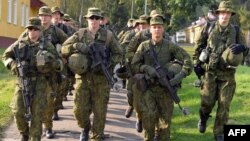With its mild climate and shuttered nuclear reactor, Lithuania's more than 20 years of independence have been largely free of both natural and technological disasters.
But a new emergency-response manual being distributed by the Defense Ministry aims to prepare Lithuanians for a catastrophe far worse than a chemical spill or the occasional tornado.
The 98-page guide, which this week goes out to libraries and army personnel in the 3-million-strong Baltic nation, is meant to gird citizens for the possibility of invasion, occupation, and armed conflict.
The manual, entitled "How To Act In Extreme Situations Or Instances Of War," may seem an overly anxious measure in a country like Lithuania, which lived under Soviet control from 1940-1991 but has enjoyed the security of European Union and NATO membership since 2004.
Nonetheless, officials in Vilnius say the past year in Ukraine, with the annexation of Crimea and deadly fighting in the country's eastern Donbas region, has shown that Russia remains a danger to all of its neighbors.
"When Russia started its aggression in Ukraine, our citizens here in Lithuania understood that our neighbor is not friendly," said Lithuanian Defense Minister Juozas Olekas in an interview with the Reuters news agency.
The examples of Georgia and Ukraine -- which have both lost parts of their territory in wars with Russia or pro-Russian separatists -- "show us that we cannot rule out a similar kind of situation here," added Olekas, who noted in the manual's introduction that he had received "frequent questions about our homeland defense from ordinary Lithuanian citizens."
The publication, which is also available for download from the Defense Ministry website offers suggestions and practical advice for everything from converting cellars to shelters to knowing how to react when enemy soldiers show up at family homes.
It also includes instructions for appropriate forms of civil disobedience in the event of an occupation -- strikes, blockades, disinformation, and the online organization of cyberattacks against the enemy.
Although the publication makes no specific mention of Russia, it offers advice on how to respond in a "hybrid war" situation involving armed soldiers with no insignia or any evident government affiliation -- an obvious reference to the war in Ukraine, where Moscow has repeatedly rejected accusations of providing arms and soldiers to support separatist militia fighters.
"Lithuanian citizens who notice unknown and unidentified armed groups operating in their neighborhood or elsewhere should notify the authorities," the manual advises, adding that the Lithuanian armed forces have newly operational rapid-reaction units that can "respond to a threat and neutralize it."
Contingency Plans
The pamphlet's tone is no-nonsense and occasionally wry. Gunshots outside your window "are not the end of the world," one section admonishes. Another line urges that passive resistance should, at the very least, involve "doing your job worse than usual."
But many of the scenarios outlined in the manual are deeply alarming in a country with a 50-year history of violent Soviet occupation, and which just last week marked the anniversary of a bloody confrontation between independence demonstrators and Soviet troops in 1991.
Despite its NATO and EU membership, Lithuania's geographic location leaves it permanently in peril, uncomfortably squeezed between Russia-friendly Belarus and Russia's own Kaliningrad Oblast, a coastal exclave and home to Moscow's Baltic Sea Fleet.
The Kremlin, meanwhile, has begun to ramp up another form of pressure against Lithuania, threatening to prosecute approximately 1,500 Lithuanians who deserted mandatory military service under the Soviet Union.
Russia, which is suspected of using its weapons and soldiers to aid separatist aims in eastern Ukraine, may be using the threat against Lithuania as a way of expressing its disapproval of Vilnius's open support of the Kyiv government and Ukrainian troops.
With this in mind, the Defense Ministry manual prepares Lithuanians for the notion of possible evacuation, a prospect that would involve a drive south to Poland or west to the coast, to catch ferry transport to Poland, Germany, Sweden, or Finland. (The coastline headquarters of Lithuania's LNG gas terminal, of strategic value to any foreign invader, makes departure by sea potentially dangerous, however.)
Lithuanians are being advised to make contingency plans in case of evacuation: keeping car tanks full, packing food and supplies in advance, and considering the special needs of elderly family members, small children, and pets.
In the meantime, Lithuania is slowly strengthening its military apparatus, aiming to raise defense spending to 1.1 percent of GDP this year, and to NATO's own recommended target of 2 percent by 2020.















